Effects of Drought on Nutrient Uptake and the Levels of Nutrient-Uptake Proteins in Roots of Drought-Sensitive and -Tolerant Grasses
- PMID: 29601475
- PMCID: PMC6027393
- DOI: 10.3390/plants7020028
Effects of Drought on Nutrient Uptake and the Levels of Nutrient-Uptake Proteins in Roots of Drought-Sensitive and -Tolerant Grasses
Abstract
Climate change will increase drought in many regions of the world. Besides decreasing productivity, drought also decreases the concentration (%) of nitrogen (N) and phosphorous (P) in plants. We investigated if decreases in nutrient status during drought are correlated with decreases in levels of nutrient-uptake proteins in roots, which has not been quantified. Drought-sensitive (Hordeum vulgare, Zea mays) and -tolerant grasses (Andropogon gerardii) were harvested at mid and late drought, when we measured biomass, plant %N and P, root N- and P-uptake rates, and concentrations of major nutrient-uptake proteins in roots (NRT1 for NO₃, AMT1 for NH₄, and PHT1 for P). Drought reduced %N and P, indicating that it reduced nutrient acquisition more than growth. Decreases in P uptake with drought were correlated with decreases in both concentration and activity of P-uptake proteins, but decreases in N uptake were weakly correlated with levels of N-uptake proteins. Nutrient-uptake proteins per gram root decreased despite increases per gram total protein, because of the larger decreases in total protein per gram. Thus, drought-related decreases in nutrient concentration, especially %P, were likely caused, at least partly, by decreases in the concentration of root nutrient-uptake proteins in both drought-sensitive and -tolerant species.
Keywords: climate change; drought; nutrient uptake; nutrient-uptake protein; roots.
Conflict of interest statement
The authors declare no conflicts of interest.
Figures


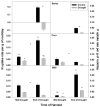
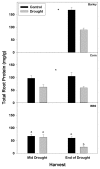
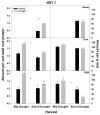
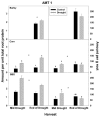
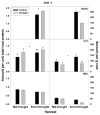
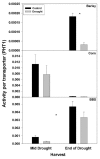
Similar articles
-
Effect of drought and carbon dioxide on nutrient uptake and levels of nutrient-uptake proteins in roots of barley.Am J Bot. 2020 Oct;107(10):1401-1409. doi: 10.1002/ajb2.1542. Epub 2020 Oct 6. Am J Bot. 2020. PMID: 33021337
-
Impact of a short-term heat event on C and N relations in shoots vs. roots of the stress-tolerant C4 grass, Andropogon gerardii.J Plant Physiol. 2014 Jul 15;171(12):977-85. doi: 10.1016/j.jplph.2014.04.006. Epub 2014 Apr 24. J Plant Physiol. 2014. PMID: 24974323
-
Arbuscular Mycorrhizal Fungi Mediated Enhanced Biomass, Root Morphological Traits and Nutrient Uptake under Drought Stress: A Meta-Analysis.J Fungi (Basel). 2022 Jun 23;8(7):660. doi: 10.3390/jof8070660. J Fungi (Basel). 2022. PMID: 35887417 Free PMC article.
-
Getting to the roots of N, P, and K uptake.J Exp Bot. 2023 Mar 28;74(6):1784-1805. doi: 10.1093/jxb/erad035. J Exp Bot. 2023. PMID: 36708176 Review.
-
Root proteases: reinforced links between nitrogen uptake and mobilization and drought tolerance.Physiol Plant. 2012 May;145(1):165-79. doi: 10.1111/j.1399-3054.2012.01573.x. Epub 2012 Feb 23. Physiol Plant. 2012. PMID: 22242864 Review.
Cited by
-
Maize Production under Drought Stress: Nutrient Supply, Yield Prediction.Plants (Basel). 2023 Sep 18;12(18):3301. doi: 10.3390/plants12183301. Plants (Basel). 2023. PMID: 37765465 Free PMC article.
-
Growth responses and differential expression of VrDREB2A gene at different growth stages of mungbean (Vigna radiata L. Wilczek) under drought stress.Physiol Mol Biol Plants. 2021 Nov;27(11):2447-2458. doi: 10.1007/s12298-021-01089-w. Epub 2021 Oct 26. Physiol Mol Biol Plants. 2021. PMID: 34924703 Free PMC article.
-
High-Temperature and Drought Stress Effects on Growth, Yield and Nutritional Quality with Transpiration Response to Vapor Pressure Deficit in Lentil.Plants (Basel). 2021 Dec 28;11(1):95. doi: 10.3390/plants11010095. Plants (Basel). 2021. PMID: 35009098 Free PMC article.
-
Sodium Nitroprusside Improves the Growth and Behavior of the Stomata of Silybum marianum L. Subjected to Different Degrees of Drought.Life (Basel). 2023 Mar 24;13(4):875. doi: 10.3390/life13040875. Life (Basel). 2023. PMID: 37109404 Free PMC article.
-
Applying microbial biostimulants and drought-tolerant genotypes to enhance barley growth and yield under drought stress.Front Plant Sci. 2025 Jan 7;15:1494987. doi: 10.3389/fpls.2024.1494987. eCollection 2024. Front Plant Sci. 2025. PMID: 39840355 Free PMC article. Review.
References
-
- Intergovernmental Panel on Climate Change . Climate Change 2007: Synthesis Report. IPCC; Geneva, Switzerland: 2007.
-
- Intergovernmental Panel on Climate Change . Climate Change 2014: Synthesis Report. IPCC; Geneva, Switzerland: 2014.
-
- Pereira J., Chaves M.M., Caldeira M.C., Correia A.V. Water availability and productivity. In: Morison J.I.L., Morecroft M.D., editors. Plant Growth and Climate Change. Blackwell Publishing Ltd.; Oxford, UK: 2006. pp. 118–145.
-
- De Boeck H.J., Dreesen F.E., Janssens I.A., Nijs I. Climatic characteristics of heat waves and their simulation in plant experiments. Glob. Chang. Biol. 2010;16:1992–2000. doi: 10.1111/j.1365-2486.2009.02049.x. - DOI
LinkOut - more resources
Full Text Sources
Other Literature Sources

